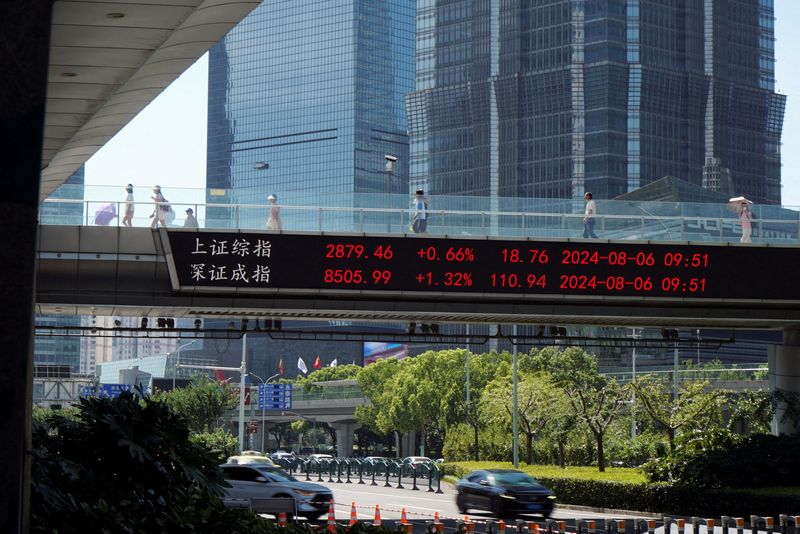Chinese stocks experienced a significant rally on Thursday, driven by expectations that upcoming fiscal stimulus measures would be detailed in a briefing from finance officials over the weekend. The mainland market was particularly buoyed by the People’s Bank of China’s initiation of a 500 billion yuan facility aimed at invigorating capital markets. This move is part of a broader package of stimulus measures announced in late September. As a result, China’s blue-chip CSI300 index surged by approximately 3%, recovering some losses from the previous day’s 7% drop, which was largely attributed to investor concerns regarding the vagueness of the initial stimulus announcement. Similarly, Hong Kong’s Hang Seng index rebounded over 4% after a 1.3% decline on Wednesday and has shown a 26% increase this year. This collective movement led to the MSCI’s broadest index of Asia-Pacific shares outside Japan rising by 1.25%, with futures indicating a slightly improved outlook for European markets.
The heightened interest in the upcoming finance ministry press conference, scheduled for Saturday, has shifted market focus toward elucidating the fiscal stimulus plan. Expectations from market analysts suggest a potential fiscal stimulus size between 2 trillion to 3 trillion yuan, emphasizing the need for clear governmental support to sustain the recent rally in Chinese markets. Richard Tang, a China strategist at Julius Baer, highlighted this consensus view and noted that further announcements regarding fiscal measures are likely in the coming weeks. The past week has been exceptionally volatile for Chinese equities, with mainland shares peaking at two-year highs after the National Day holiday only to subsequently encounter significant declines due to uncertainty surrounding the stimulus details.
Investor sentiment is further influenced by recent comments from Nicholas Yeo, head of China equities at abrdn, who posited that new policy adjustments indicate a transformative shift in the level of support; he reiterated that tangible fiscal support is essential for the momentum to persist. Notably, the CSI300 and Shanghai Composite index have appreciated by 26% and 22%, respectively, since the announcement of the initial stimulus measures. The market’s volatility underscores how closely tied investor confidence is to governmental policy actions, emphasizing the critical role such measures play in stabilizing and promoting economic growth.
Meanwhile, in the U.S., the stock market has reached record highs, particularly the S&P 500 and the Dow, buoyed by the release of the Federal Reserve’s meeting minutes. These minutes revealed a prevailing consensus among Fed officials favoring a more relaxed monetary policy approach, including the prospect of a significant half-point rate cut. However, the meeting notes also conveyed caution regarding the pace of future rate reductions, contributing to a complex market narrative. Investors have since begun adjusting their expectations; the CME FedWatch tool indicates an 82% probability of a 25 basis point cut next month, as optimism about aggressive rate cuts diminished following a robust U.S. jobs report.
The anticipation surrounding Thursday’s consumer price index (CPI) data adds another layer of complexity to the market outlook. Economists project that core inflation will remain steady at 3.2% year-on-year, but an unexpectedly high inflation reading could result in upward adjustments to yields and renewed skepticism regarding the Fed’s easing trajectory. This uncertainty has spurred fluctuations in the dollar, which has recently strengthened against its rivals, reaching its highest level since mid-August. The intricate dynamics surrounding U.S. monetary policy and inflation paint a picture of cautious optimism for investors as they await more definitive indicators about the Fed’s future actions.
In the commodities market, oil prices have increased amid rising geopolitical tensions in the Middle East and an uptick in demand due to a significant storm impacting Florida. As a consequence, Brent crude futures rose by 0.78% to $77.18 per barrel, while U.S. West Texas Intermediate futures climbed 0.83% to $73.85 per barrel. The confluence of supply concerns and demand fluctuations presents a challenging landscape for energy markets, which remain sensitive to both geopolitical developments and domestic economic indicators. Overall, the current financial climate is characterized by a blend of optimism rooted in anticipated fiscal stimuli and caution underscored by inflation concerns, creating a complex backdrop for investors navigating these turbulent markets.

